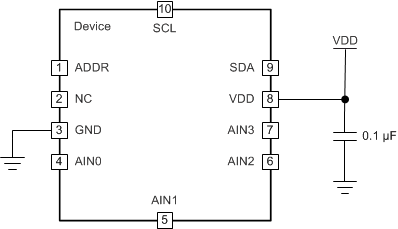SBAS846 November 2017 TLA2021 , TLA2022 , TLA2024
PRODUCTION DATA.
- 1 Features
- 2 Applications
- 3 Description
- 4 Revision History
- 5 Device Comparison Table
- 6 Pin Configuration and Functions
- 7 Specifications
- 8 Detailed Description
- 9 Register Maps
- 10Application and Implementation
- 11Power Supply Recommendations
- 12Layout
- 13Device and Documentation Support
- 14Mechanical, Packaging, and Orderable Information
Package Options
Mechanical Data (Package|Pins)
- RUG|10
Thermal pad, mechanical data (Package|Pins)
Orderable Information
11 Power Supply Recommendations
The device requires a single unipolar supply (VDD) to power the analog and digital circuitry of the device.
11.1 Power-Supply Sequencing
Wait approximately 50 µs after VDD is stabilized before communicating with the device to allow the power-up reset process to complete.
11.2 Power-Supply Decoupling
Good power-supply decoupling is important to achieve optimum performance. As shown in Figure 27, VDD must be decoupled with at least a 0.1-µF capacitor to GND. The 0.1-µF bypass capacitor supplies the momentary bursts of extra current required from the supply when the device is converting. Place the bypass capacitor as close to the power-supply pin of the device as possible using low-impedance connections. Use multilayer ceramic chip capacitors (MLCCs) that offer low equivalent series resistance (ESR) and inductance (ESL) characteristics for power-supply decoupling purposes. For very sensitive systems, or for systems in harsh noise environments, avoid using vias to connect the capacitors to the device pins for better noise immunity. The use of multiple vias in parallel lowers the overall inductance and is beneficial for connections to ground planes.
 Figure 27. TLA202x Power-Supply Decoupling
Figure 27. TLA202x Power-Supply Decoupling